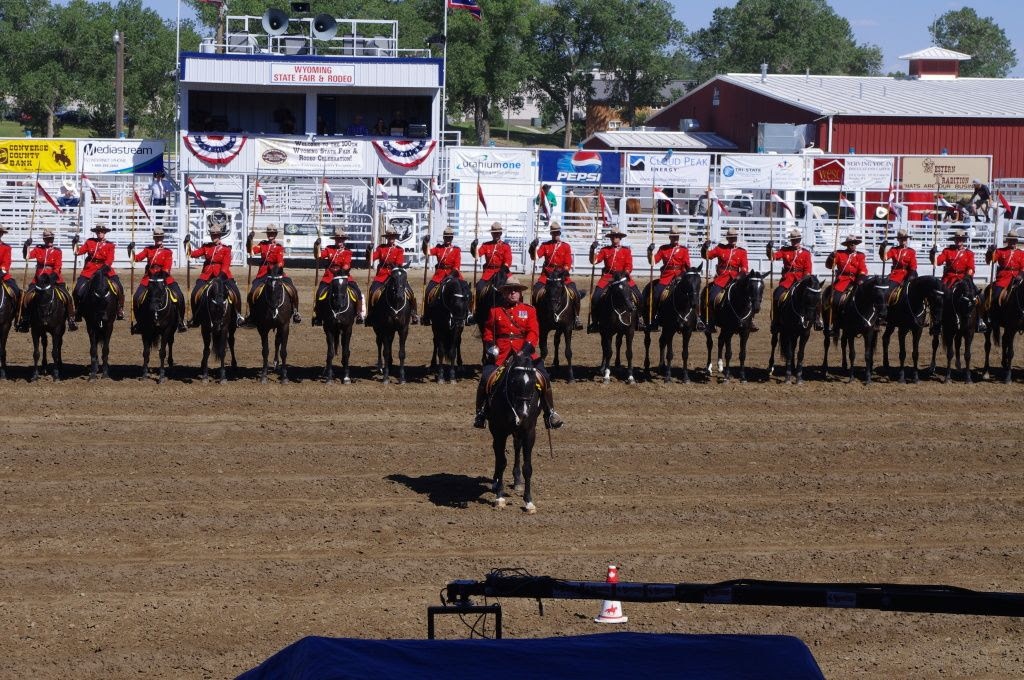On this day in 1920 the recently merged Royal North West Mounted Police and the Dominion Police Force officially became the Royal Canadian Mounted Police.
Mountie of the Royal Canadian Mounted Police, circa 1930s.
This is undoubtedly confusing for people who associate the Mounties, as they are called, with the 19th Century, but the RCMP celebrates its 100th anniversary today.
The confusion is no doubt created by the fact that the well known prior police force, whose troopers were also called Mounties, the North West Mounted Police, dated back to 1873. The NWMP was formed to patrol the Canadian West and adopted the famous scarlet color as the Indian population associated it with authority due to the British Army. The NWMP came to ultimately wear a uniform that for all practical purposes is the one we associate with the RCMP today.
Troopers of the NWMP at Fort Walsh, 1878 in early uniforms with British style "pill box" caps.
It was the NWMP that established the reputation of the Mounties for "always getting their man" and brave, risky, solitary action. They also established the Mounties appearance, adopting, unofficially at first, the Stetson hat that still prominently features in the RCMP uniform.
Mountie of the North West Mounted Police in the Yukon, 1917. This Mountie is carrying a Ross rifle, formerly the rifle of the Canadian Army, and is riding a stock saddle. Stock saddles were the norm for Mounties for much of their mounted history. His Stratchcona boots, adopted by Canadain volunteers during the Boer War and still used by the RCMP today, are also easily identifiable in the photo.
In later years the North West Mounted Police was renamed the Royal North West Mounted Police in 1904, bringing the name close to that of the RCMP. During the Boer War it contributed men to volunteer forces that served in South Africa and in 1918 it contributed two units directly to the Empire forces in Europe, and then in Russia, over the objection of the Canadian military which felt that there was no need for cavalry to be sent at that time. The sending of Mounties in fact blurred their purpose somewhat as it caused a force which was military in organization but a police force to actually take on a military role for a time while also putting a strain on police functions in Canada itself, as the war had so depleted the number of men serving in the RNWMP.
Dawson, Yukon Territory.
While the North West Mounted Police covered the vast Canadian west, in the east the Canadian federal police force was the Dominion Police Force, which had been formed in 1868. We hear a great deal less about it, no doubt because its role was less dramatic. During World War One it was folded into the Canadian Army for a time. Following the war the decreased need for a force of the type of the North West Mounted Police and the increased need for a central Canadian police force caused the merger of the two, which officially became the Royal Canadian Mounted Police on this day in 1920.
Royal Canadian Musical Ride at the Wyoming State Fair, 2012.
The RCMP has existed ever since, although its no longer a mounted service and its famous scarlet uniform is now only a dress uniform. It's final existence in its original frontier form was waning even at the time of its creation. Even so, all Mounties were required to learn to ride until 1966, a fact which reflects Canada's vast wild nature. At the same time, following its creation, it took on many of the same duties that the Federal Bureau of Investigation occupies in the United States while also retaining provincial policing duties, often by contract with local entities.
Purely coincidentally, today is also the date that marks the formation of the South African Air Force which holds the status as the world's second independent air force. I.e., it was a service separate from the Army. The Royal Air Force holds the status of being the world's first independent air force, acquiring that status on April 1, 1918.
Airco D.H.9, several of which were given by the United Kingdom to the Dominion of South Africa.
The date cold legitimately be debated as in reality it marks the date on which Col Pierre van Ryneveld was appointed the South African Director Air Service with the task of creating the South African Air Force. South African had been given several military aircraft for the purpose of creating an air arm, and his task was to do that. Interestingly, Van Ryneveld was not in South Africa at the time and had just been recalled from the UK to assume his new duties. He returned at the controls of a Vickers Vimy, which he flew all the way from the UK with co-pilot Quintin Brand. Both Van Ryneveld and Brand were knighted for the feat.
Van Ryneveld left, and Brand right, February 1920.
Van Ryneveld commanded the new South African Air Force officially until 1933 and then unofficially until 1937 after which time he was the head of the South African General Staff, a position he occupied until 1949. The dual role existed as no replacement was chosen for his air force role until 1937. He died at age 81 in 1972. Brand, who as also South African, remained in the RAF and returned to the UK to resume his duties with it. He played an important and successful role as an RAF commander during the Battle of Britain but was on the wrong side of the internal British tactical debate on the "Big Wing" theory and was sidelined and retired in 1943, during the midst of the Second World War. Following his retirement he married for the second time at age 50, marrying the sister of his first wife who had died in 1941. The couple retired to what was then Rhodesia in 1950 and he died at age 74 in 1968.




























